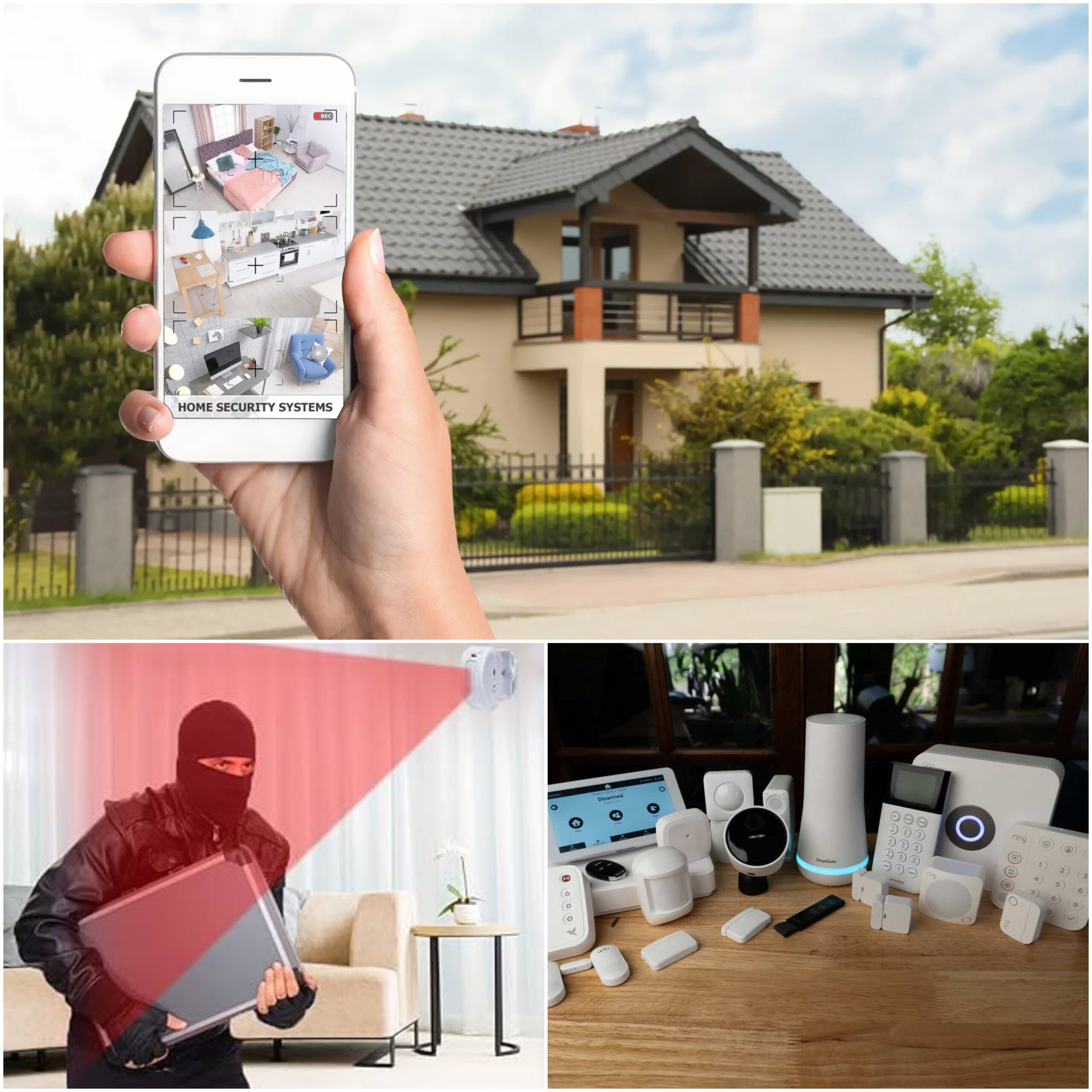DIY home security provides people the ability to take charge of their own protection, in contrast to traditional security systems that might need expert installation and monitoring services.
When it comes to home security, the Do-It-Yourself (DIY) method is a useful and affordable way for homeowners to improve their security measures.
Let’s explore the importance of home security and the different do-it-yourself strategies you can use to properly protect your house.
Table of Contents
DIY Home Security
Assessing Your Home Security Needs
To effectively customize your approach, you must evaluate your special security requirements. On regular basis new researches are coming on home security. If those new ideas can be implemented for your home security that will be great. This is how you can begin,

Identify Potential Vulnerabilities
To start, provide your house with a thorough inspection to find any potential weak points.
This involves checking windows, garage doors, and other entry points for weaknesses that robbers might exploit.
Keep an eye out for areas that could be dangerous for security, like places with poor visibility, and worn-out or insufficient locks.
Understand Common Threats in Your Area
Every neighborhood may experience a different set of safety concerns, from minor theft to more noteworthy break-ins.
To learn more about typical threats in your neighborhood, look up local crime statistics and speak with nearby residents.
It will be easier for you to prioritize security measures and spend resources correctly if you are aware of the specific risks that you may face.
Set Goals for Your DIY Home Security System
After deciding potential weak points and evaluating nearby dangers it is time to set specific objectives for your do-it-yourself home security system.
Decide what you want to accomplish with your security measures, is it to keep burglars away, safeguard valuables, or improve family safety?
Creating realistic goals will help you make better choices as you put your needs-specific DIY security measures into practice.
“You can create the groundwork for a strong DIY home security system that effectively addresses weaknesses and defends against potential threats by proactively checking your home security needs.
Knowing exactly what kind of security you need will help you put into practice sensible, customized solutions to safeguard your family and your house.”
Budgeting and Planning
Set a Budget for Your DIY Home Security Project
Set up your budget before beginning any best DIY home security system installation.
Take note of your financial status and rank the most important security measures according to your means.
Since it may be tempting to spend a lot of money on high-tech devices, keep in mind that there are many reasonably priced alternatives that can still offer dependable home security.
Research and Select Affordable Security Options
After deciding on a budget, look into reasonably priced security solutions that fit your requirements and available funds.
Look at a wide range of items, including motion-activated lights, door and window alarms, security cameras, and smart locks, to compare features and costs to discover the best deal.
To confirm the reliability and effectiveness of your selected DIY home security solutions, be sure to read reviews and ask for recommendations from reputable sources.
Create a Timeline and Action Plan for Implementation
Make a schedule and an action plan for placing your homemade home security measures into action, keeping your security options and budget in mind.
Divide your project into smaller, simpler tasks, and set each phase of the process a reasonable deadline.
Before you execute your security measures, take into consideration things like installation duration, equipment placing an order or purchase, and any other necessary setups.
You can maintain organization and focus while working to improve the security of your house by creating a clear timeframe and action plan.
Read: STOP! Don’t Renovate Until You See This (Shocking Inspection Results)
DIY Home Security Measures
Securing Entry Points
1. Reinforcing Doors and Windows:
Start by determining how strong your windows and doors are.
To make the latches and strike plates more resistant to forced entry, promote weak spots by screwing longer screws into them.
For added security, especially for basement or ground-level windows, think about installing door and window bars or grilles.
2. Installing Deadbolts and Door/Window Sensors:
Your doors are more secure when they have deadbolt locks installed, which increases their difficulty of breaching.
Make sure that the deadbolts on all external doors are of the highest caliber and penetrate deeply into the door frame.
Installing door and window sensors guide you to sound an alarm when a door or window is opened. It helps to warn you of possible burglars are another thing to think about.
These sensors work well as a DIY home security solution because they are frequently inexpensive and simple to install.
Enhancing Outdoor Security
1. Installing Motion-Sensor Lights:
When motion is detected, motion-sensor lights show the dark areas around your home, helping as a powerful deterrent against intruders.
Install motion-sensor lighting along walkways, in shadowy areas of your yard, and close to entry points like windows and doors.
These lights give you and your family more visibility and safety at night while also stopping possible intruders.
2. Maintaining Landscaping for Visibility:
Maintaining the landscape can guarantee that there are no hidings places for trespassers and that everyone can see clearly around your property.
To prevent unwanted access and reduce potential hiding places, remove the bushes and shrubs next to windows and doors.
For added security against intruders trying to enter your home through ground-floor windows, think about placing prickly plants or thorny bushes beneath them.
Implementing Surveillance
1. Setting up Security Cameras:
By placing DIY home security cameras around your house, you can keep an eye on activities inside and outside of it and provide a visual deterrent to would-be burglars.
Select top-notch cameras with features including motion detection, night vision, and remote access. Install cameras in strategic locations on your property, like driveways, entry points, and other weak spots.
For best coverage and visibility, make sure the installation and positioning are done correctly.
2. Utilizing Smart Doorbells:
Even when your home is empty, you can keep an eye on and engage with visitors to your door with the help of a smart doorbell.
With the built-in cameras, motion sensors, and two-way audio communication that these devices typically offer, you can see and talk with guests from your smartphone or tablet.
To improve security and ward off potential intruders or porch pirates, install a smart doorbell at your front door.
Also, for increased functionality, some models come equipped with extra features like package detection and integration with other smart home appliances.
Utilizing Technology
1. Installing Smart Locks and Alarms:
With the help of a smartphone app, you can lock and unlock doors from anywhere in your house with smart locks’ keyless entry and remote access control features.
When smart locks and compatible alarm systems are paired, a combined safety system that improves convenience and protection is offered.
In the event of an unauthorized entry or suspicious activity, smart alarms can be set up to instantly notify your smartphone.
This allows you to take immediate action and, if needed, notify the authorities.
2. Set up a DIY Alarm System Using Apps:
With inexpensive sensors and smartphone apps, you can make a personalized DIY alarm system to keep an eye on activities around your house.
Install sensors on doors and windows that sound an alarm if they are unexpectedly opened. Connect these sensors to a smartphone app or central hub to receive real-time alerts about possible breaches.
For complete coverage and security, think about adding motion detectors, glass break sensors, and other smart DIY home security devices.
Establish Neighborhood Watch and Communication Channels
1. Organizing a Neighborhood Watch Program:
To encourage community safety and alertness, organize a neighborhood watch program with your neighbors.
Organize meetings to talk about security issues, exchange details about recent incidents, and come up with preventative measures to deal with potential threats.
Select coordinators or block captains to help residents coordinate and communicate with one another.
2. Creating Communication Channels:
To help neighbors communicate quickly and effectively, set up channels of communication like messaging apps, social media groups, and email lists.
Share critical information via these channels, report shady activity, and plan neighborhood watch patrols and events.
To promote a sense of community and support among neighbors, remind them to be watchful and watch out for one another.
Read: 20 Home Renovation Trends in the USA – What’s Hot Right Now?
Maintenance and Monitoring
Regular Maintenance of Security Equipment
You must perform routine maintenance checks on your security equipment to guarantee the best possible performance.
Inspecting security cameras, sensors, alarms, and other devices for wear, damage, or malfunctions is part of this process.
Maintaining clear vision and reliable operation requires periodically cleaning cameras and sensors.
To make sure all parts of wireless devices are functioning properly, test them frequently and replace the batteries.
Monitoring Alerts and Updates
Keep an eye out for updates and alerts from your DIY home security system to stay informed and prepared.
To get immediate alerts in the case of a system malfunction or security breach, enable notifications on your email or smartphone.
Keep your security devices up to date with firmware as well as software upgrades so that they have the newest features and dangerous patches.
To spot any odd or suspicious activity around your house, check activity logs and security camera footage regularly.
Testing Security Measures Periodically
Make sure your security measures are working as wanted by testing them regularly.
To measure the ability to react to your alarm system and the success of your security precautions, run fake break-in scenarios.
Check that motion detectors, door and window sensors, and other gadgets properly start alerts and notifications by testing them.
Take this chance to adjust settings and make any required changes to boost the overall performance of your DIY home security system.
Bottom Line
The comfort and sense of security achieved from DIY home security are priceless, so keep that in mind.
It provides you with a sense of trust and security that is really valuable to know that you have taken precautions to protect your home against potential threats.
So, avoid leaving it too late. Invest in your safety and security by beginning your DIY home security project right now.
You can create a more secure and safe home environment that will offer you and your loved ones peace of mind for years to come with focus, dedication, and the appropriate tools and resources.
Read: Intruders HATE This Security System (Cops Called in 3 Minutes!)












One thought on “DIY Home Security: Effective Measures You Can Implement Today”